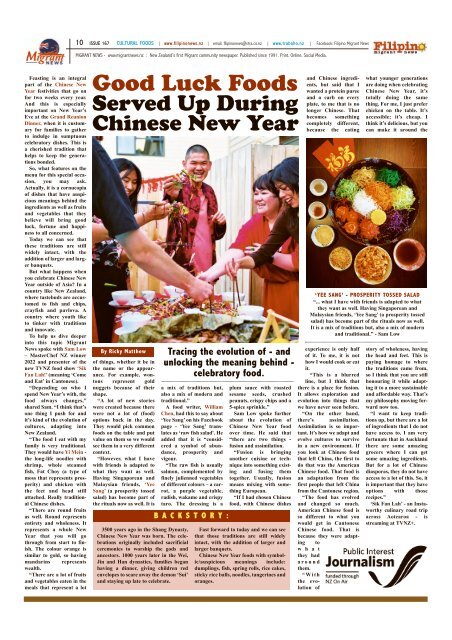Filipino News 167
www.filipinonews.nz : New Zealand's ONLY Filipino Community Newspaper for the last 22 years! email: filipinonews@xtra.co.nz; www.filipinonews.nz; FB: Filipino News NZ
www.filipinonews.nz : New Zealand's ONLY Filipino Community Newspaper for the last 22 years! email: filipinonews@xtra.co.nz; www.filipinonews.nz; FB: Filipino News NZ
You also want an ePaper? Increase the reach of your titles
YUMPU automatically turns print PDFs into web optimized ePapers that Google loves.
10 ISSUE <strong>167</strong> CULTURAL FOODS | www.filipinonews.nz | email: filipinonews@xtra.co.nz | www.trabaho.nz | Facebook: <strong>Filipino</strong> Migrant <strong>News</strong><br />
MIGRANT NEWS - www.migrantnews.nz : New Zealand’s first Migrant community newspaper. Published since 1991. Print. Online. Social Media.<br />
Feasting is an integral<br />
part of the Chinese New<br />
Year festivities that go on<br />
for two weeks every year.<br />
And this is especially<br />
important on New Year’s<br />
Eve at the Grand Reunion<br />
Dinner, when it is customary<br />
for families to gather<br />
to indulge in sumptuous<br />
celebratory dishes. This is<br />
a cherished tradition that<br />
helps to keep the generations<br />
bonded.<br />
So, what features on the<br />
menu for this special occasion,<br />
you may ask.<br />
Actually, it is a cornucopia<br />
of dishes that have auspicious<br />
meanings behind the<br />
ingredients as well as fruits<br />
and vegetables that they<br />
believe will bring good<br />
luck, fortune and happiness<br />
to all concerned.<br />
Today we can see that<br />
these traditions are still<br />
widely intact, with the<br />
addition of larger and larger<br />
banquets.<br />
But what happens when<br />
you celebrate Chinese New<br />
Year outside of Asia? In a<br />
country like New Zealand,<br />
where tastebuds are accustomed<br />
to fish and chips,<br />
crayfish and pavlova. A<br />
country where youth like<br />
to tinker with traditions<br />
and innovate.<br />
To help us dive deeper<br />
into this topic Migrant<br />
<strong>News</strong> spoke with Sam Low<br />
– MasterChef NZ winner<br />
2022 and presenter of the<br />
new TVNZ food show ‘Sik<br />
Fan Lah!’ (meaning ‘Come<br />
and Eat’ in Cantonese).<br />
“Depending on who I<br />
spend New Year’s with, the<br />
food always changes,”<br />
shared Sam. “I think that’s<br />
one thing I push for and<br />
it’s kind of the evolution of<br />
cultures, adapting into<br />
New Zealand.<br />
“The food I eat with my<br />
family is very traditional.<br />
They would have Yi Mein -<br />
the long-life noodles with<br />
shrimp, whole steamed<br />
fish, Fat Choy (a type of<br />
moss that represents prosperity)<br />
and chicken with<br />
the feet and head still<br />
attached. Really traditional<br />
Chinese dishes.<br />
“There are round fruits<br />
as well. Round represents<br />
entirety and wholeness. It<br />
represents a whole New<br />
Year that you will go<br />
through from start to finish.<br />
The colour orange is<br />
similar to gold, so having<br />
mandarins represents<br />
wealth.<br />
“There are a lot of fruits<br />
and vegetables eaten in the<br />
meals that represent a lot<br />
Good Luck Foods<br />
Served Up During<br />
Chinese New Year<br />
By Ricky Matthew<br />
of things, whether it be in<br />
the name or the appearance.<br />
For example, wontons<br />
represent gold<br />
nuggets because of their<br />
shape.<br />
“A lot of new stories<br />
were created because there<br />
were not a lot of (food)<br />
options back in the day.<br />
They would pick common<br />
foods on the table and put<br />
value on them so we would<br />
see them in a very different<br />
context.<br />
“However, what I have<br />
with friends is adapted to<br />
what they want as well.<br />
Having Singaporean and<br />
Malaysian friends, ‘Yee<br />
Sang’ (a prosperity tossed<br />
salad) has become part of<br />
the rituals now as well. It is<br />
3500 years ago in the Shang Dynasty,<br />
Chinese New Year was born. The celebrations<br />
originally included sacrificial<br />
ceremonies to worship the gods and<br />
ancestors. 1000 years later in the Wei,<br />
Jin and Han dynasties, families began<br />
having a dinner, giving children red<br />
envelopes to scare away the demon ‘Sui’<br />
and staying up late to celebrate.<br />
Tracing the evolution of - and<br />
unlocking the meaning behind -<br />
celebratory food.<br />
a mix of traditions but,<br />
also a mix of modern and<br />
traditional.”<br />
A food writer, William<br />
Chen, had this to say about<br />
‘Yee Sang’ on his Facebook<br />
page - ‘Yee Sang’ translates<br />
as ‘raw fish salad'. He<br />
added that it is “considered<br />
a symbol of abundance,<br />
prosperity and<br />
vigour.<br />
“The raw fish is usually<br />
salmon, complemented by<br />
finely julienned vegetables<br />
of different colours – a carrot,<br />
a purple vegetable,<br />
radish, wakame and crispy<br />
taro. The dressing is a<br />
B A C K S T O R Y :<br />
plum sauce with roasted<br />
sesame seeds, crushed<br />
peanuts, crispy chips and a<br />
5-spice sprinkle.”<br />
Sam Low spoke further<br />
about the evolution of<br />
Chinese New Year food<br />
over time. He said that<br />
“there are two things -<br />
fusion and assimilation.<br />
“Fusion is bringing<br />
another cuisine or technique<br />
into something existing<br />
and fusing them<br />
together. Usually, fusion<br />
means mixing with something<br />
European.<br />
“If I had chosen Chinese<br />
food, with Chinese dishes<br />
Fast forward to today and we can see<br />
that those traditions are still widely<br />
intact, with the addition of larger and<br />
larger banquets.<br />
Chinese New Year foods with symbolic/auspicious<br />
meanings include:<br />
dumplings, fish, spring rolls, rice cakes,<br />
sticky rice balls, noodles, tangerines and<br />
oranges.<br />
and Chinese ingredients,<br />
but said that I<br />
wanted a protein puree<br />
and a carb on every<br />
plate, to me that is no<br />
longer Chinese. That<br />
becomes something<br />
completely different,<br />
because the eating<br />
experience is only half<br />
of it. To me, it is not<br />
how I would cook or eat<br />
it.<br />
“This is a blurred<br />
line, but I think that<br />
there is a place for fusion.<br />
It allows exploration and<br />
evolution into things that<br />
we have never seen before.<br />
“On the other hand,<br />
there’s assimilation.<br />
Assimilation is so important.<br />
It’s how we adapt and<br />
evolve cultures to survive<br />
in a new environment. If<br />
you look at Chinese food<br />
that left China, the first to<br />
do that was the American<br />
Chinese food. That food is<br />
an adaptation from the<br />
first people that left China<br />
from the Cantonese region.<br />
“The food has evolved<br />
and changed so much.<br />
American Chinese food is<br />
so different to what you<br />
would get in Cantonese<br />
Chinese food. That is<br />
because they were adapting<br />
to<br />
w h a t<br />
they had<br />
around<br />
them.<br />
“With<br />
the evolution<br />
of<br />
what younger generations<br />
are doing when celebrating<br />
Chinese New Year, it’s<br />
totally doing the same<br />
thing. For me, I just prefer<br />
chicken on the table. It’s<br />
accessible; it’s cheap. I<br />
think it’s delicious, but you<br />
can make it around the<br />
‘YEE SANG’ - PROSPERITY TOSSED SALAD<br />
“... what I have with friends is adapted to what<br />
they want as well. Having Singaporean and<br />
Malaysian friends, ‘Yee Sang’ (a prosperity tossed<br />
salad) has become part of the rituals now as well.<br />
It is a mix of traditions but, also a mix of modern<br />
and traditional.” - Sam Low<br />
story of wholeness, having<br />
the head and feet. This is<br />
paying homage to where<br />
the traditions came from,<br />
so I think that you are still<br />
honouring it while adapting<br />
it to a more sustainable<br />
and affordable way. That’s<br />
my philosophy moving forward<br />
now too.<br />
“I want to keep traditions<br />
up, but there are a lot<br />
of ingredients that I do not<br />
have access to. I am very<br />
fortunate that in Auckland<br />
there are some amazing<br />
grocers where I can get<br />
some amazing ingredients.<br />
But for a lot of Chinese<br />
diasporas, they do not have<br />
access to a lot of this. So, it<br />
is important that they have<br />
options with those<br />
recipes.”<br />
‘Sik Fan Lah’ - an Instaworthy<br />
culinary road trip<br />
across Aotearoa - is<br />
streaming at TVNZ+.
















